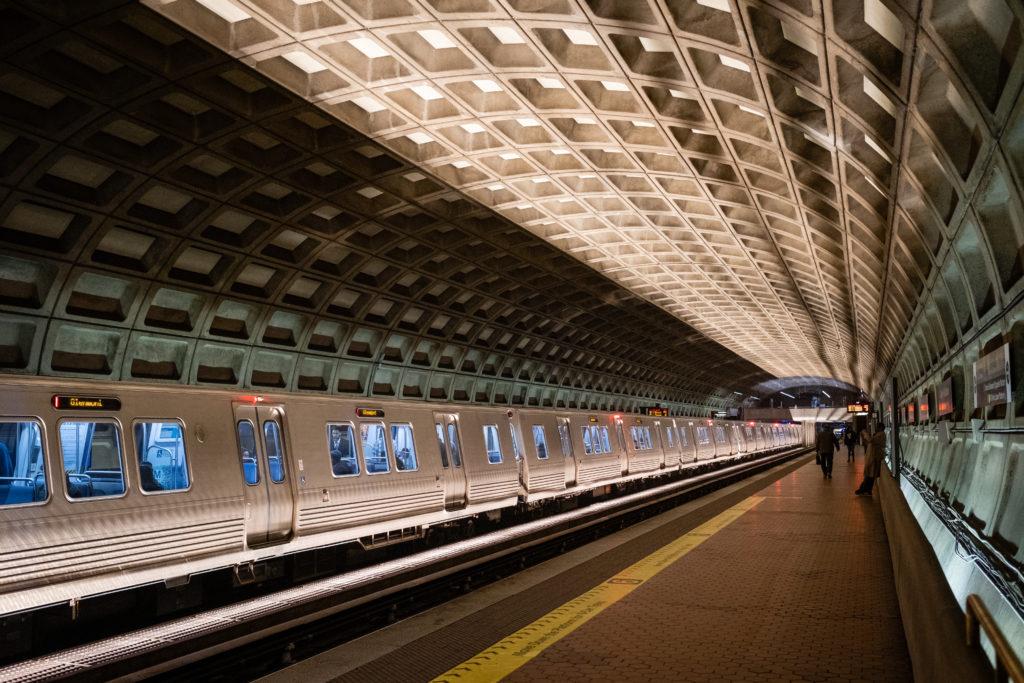Metro is scaling back its train and bus services to curb the spread of COVID-19. Here’s what you need to know if you’re still in the District.
Trains are running every 20 minutes – save for Red Line units, which run every 15 minutes – and all bus routes now run on modified Sunday schedules, according to Washington Metropolitan Area Transit Authority releases earlier this week. After closing the Smithsonian and Arlington Cemetery stations last week, Metro will entirely halt train service at 17 additional stations – not yet Foggy Bottom – beginning Thursday, according to a WMATA release.
Metrorail ridership has dropped 90 percent since Metro began reducing service, the Tuesday release states.
Metro busses now only permit entrance through rear doors, unless a rider needs to use the ADA accessible ramp at the front of the bus, to limit contact between bus drivers and passengers, according to the release. Bus service is now free to anyone who still needs to ride, but WMATA is encouraging residents to avoid using transit unless absolutely necessary, the release states.
COVID-19 has infected 187 and killed two people in the District so far, according to Johns Hopkins’ Coronavirus Resource Center.
Metro’s General Manager and CEO Paul Wiedefeld said in a release Sunday that community members should refrain from taking public transportation in an effort to prevent the spread of COVID-19, especially to bus drivers and Metro workers.
“Metro will do everything we can to protect the everyday heroes who are driving buses, running trains, monitoring stations and helping people with disabilities,” Wiedefeld said in the release. “Our frontline colleagues make a choice each day to leave their homes at a time of great anxiety and uncertainty.”
He said community members should think of public transportation as a “limited resource” when determining which mode of transportation, like walking or taking the bus, to utilize.
“If you are boarding a bus when you could walk, that increases the likelihood of the bus reaching capacity and having to bypass a stop where a nurse might be heading in to start a shift,” Wiedefeld said.
A WMATA spokesperson deferred comment to the press releases.
James Harnett, a senior and the Foggy Bottom and West End Advisory Neighborhood’s vice chair, said scaling back service was the best thing WMATA could do to prevent the spread of the virus. Harnett said Mayor Muriel Bowser, along with Virginia and Maryland governors, should order residents to stay at home for the next 14 to 21 days.
“All three jurisdictions, all three states, weren’t acting at the rate that they needed to be in order to make an impact early enough,” Harnett said. “And we’re now going to have to pay the price with more severe restrictions like we’ve seen in some parts of Washington State, California, New York.”
California, Washington State and New York have all been issued state-wide stay-at-home orders, The New York Times reported Wednesday.
Bowser declared a public health emergency and a state of emergency March 11 and banned gatherings of more than 250 people two days later. Bowser ordered the closure of non-essential businesses and gatherings of 10 or more people Tuesday.
Public transportation experts said reducing Metro service will prevent the spread of the virus, but the agency could take a financial hit because it needs to pay its employees although service is greatly reduced.
James Moore, a civil engineering professor at the University of Southern California, said discouraging ridership is an extreme measure for transit agencies to take but could be the best response given the severity of the pandemic.
More than 66,000 cases have been confirmed in the United States out of about 468,500 cases worldwide, the Johns Hopkins center shows.
“It may be that it’s appropriate for some agencies to make more extreme responses,” Moore said. “It is unusual for a transit agency to discourage ridership, you know, say restrict your use of the system only to essential trips.”
He said a transit agency’s goal is to provide transportation to community members and not turn a profit, unlike other businesses, which could impact the Metro’s decisions to scale back service.
Moore said agencies could consider completely shutting down transit to stop the spread of the virus and that transit officials should consider which critical workers rely on transit to get to work when deciding whether to shut down routes.
“It’s a hard question to answer because it’s hard to determine how big that impact is going to be,” he said. “But it’s an option that should exist in the toolkit for now. I can say honestly that the situation is serious enough that we can’t dismiss that prospect.”
Hiroyuki Iseki, an associate professor of urban studies and planning at the University of Maryland, said Metro likely won’t lose profit from a decrease in ridership but will likely take a financial hit because the agency still must pay workers’ salaries.
“Even under this current situation, the agency probably needs to pay their employees,” he said. “In that sense, the agency is not really saving money. But it’s very hard to say whether or not there is substantial financial loss.”
Ryan Norris contributed reporting.





